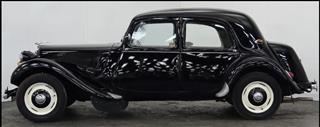

Traction Avant - Front Seat Base SpringsSeptember 2017, 5 years into ownership and another Reasonably straightforward job as part of the 'rolling restoration' (there's not a lot left to do now). At 65 years old the seat bases on my Traction sank when sat on and with closer inspection from the underneath showed some broken springs in both the drivers and passenger side. Now the seats had been recovered in leather before I bought the car 5 years ago and I thought it would be a simple job to replace the actual spring base... well it was, sought of. I sourced 2 new base springs from France and Holland which whilst the same basic layout to the original are of a slightly different construction. The original 'Systéme Epeda' are are continuous wire construction whilst the replacements are more of a 'pocketed' construction. When the seats were recovered back in 2011/2012 the upholsterer used a commercial 'staple gun' to attach the covers so it was a slow and laborious task removing them from 3 sides. I left the front attached so I could simply peel the leather cover back with a view to simply pulling it back over (wishful thinking that was...) Once peeled back there was a layer of cotton waste on top of a hessian/horsehair 'sandwich' which was sewn to the spring base with waxed string to stop it moving. Then it was a case of cutting that string to leave the spring clear and get at the 6 securing nails holding the spring to the base. Once the horsehair 'sandwich was off, the spring was removed to leave the top cover still fastened at the front edge to the wooden base plate. Rather than strip the 'sandwich' which was itself sewn together, I simply fitted an additional layer of hessian over the springs before putting the padding back, securing both with string. The hessian came from a local furniture upholsterer's and 1 metre @ £7.00 covered both seat bases. The string came from our local Asda which, whilst not 'waxed' did the job. Once the padding was secure it was on to refitting the leather cover. Last Update: 20th September 2017
|
|
OSL282